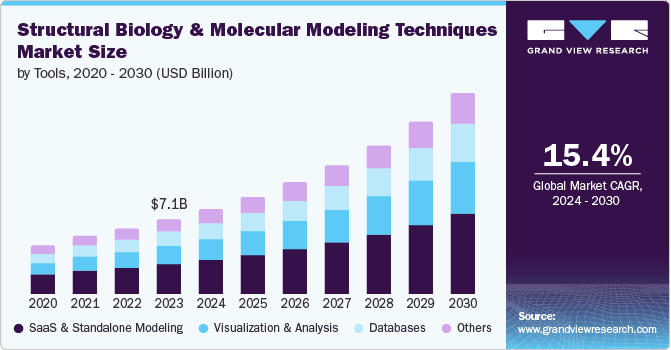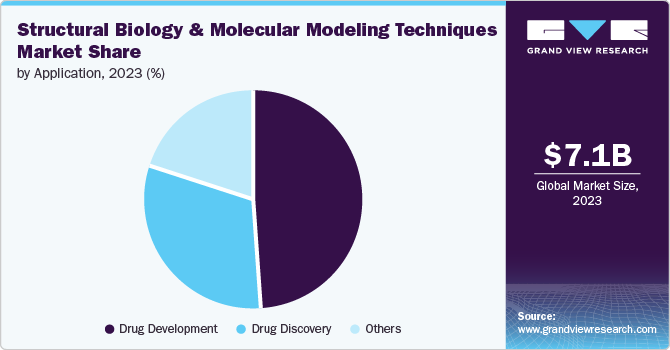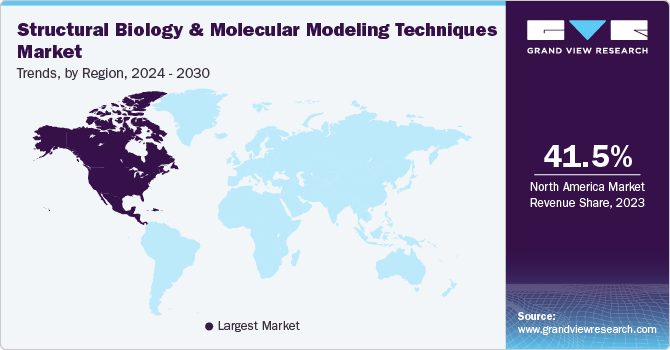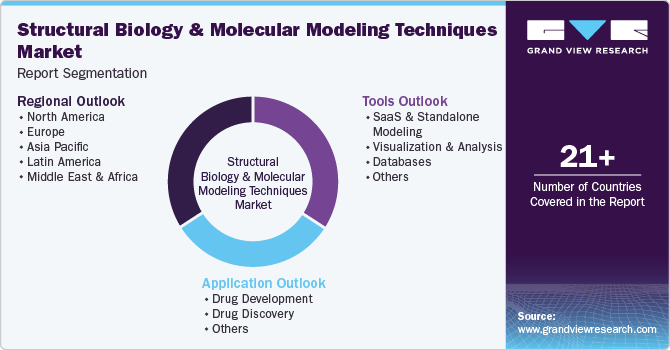
Structural Biology & Molecular Modeling Techniques Market Size, Share & Trends Analysis Report By Tools (SaaS & Standalone Modeling), By Application (Drug Development), By Region, And Segment Forecasts, 2024 - 2030
- Report ID: GVR-1-68038-737-7
- Number of Report Pages: 100
- Format: PDF
- Historical Range: 2018 - 2022
- Forecast Period: 2024 - 2030
- Industry: Healthcare
Market Size & Trends
The global structural biology & molecular modeling techniques market size was valued at USD 7.13 billion in 2023 and is projected to grow at a CAGR of 15.4% from 2024 to 2030. The increasing prevalence of chronic diseases and the subsequent demand for novel therapies are key factors contributing to the market growth. Technological advancements in structural biology & molecular modeling techniques, such as the development of high-resolution microscopy and bioinformatics tools, are also playing a significant role in propelling the market.

The rise in research and development activities in the pharmaceutical and biotechnology sectors, coupled with growing investments and funding for proteomics and genomics research, is expected to fuel market growth. Lastly, the increasing application of structural biology in drug discovery and development is another major factor driving the market expansion.
The recent convergence of artificial intelligence and machine learning in structural biology has significantly improved the speed and accuracy of modeling techniques. These technologies have empowered scientists to forecast protein structures with unprecedented precision and speed. Moreover, there has been a growing trend in using hybrid strategies, which amalgamate approaches such as X-ray crystallography, nuclear magnetic resonance (NMR), and cryo-electron microscopy. These techniques provide comprehensive insights into molecular structures, thereby driving market growth.
The growing use of single-particle analysis in cryo-EM, the application of artificial intelligence methodologies, the elucidation of membrane protein structures, the rise of using hybrid methods for structure determination, open-source software development, and the integration of structural biology into personalized medicine are all contributing to the increasing demand for these techniques, leading to significant growth and revenue in the market.
Tool Insights
SaaS (Software as a Service) and standalone modeling tools accounted for a share of 40.7% of revenue in 2023. This growth can be attributed to the crucial role these tools play in strengthening the management of chronic diseases and dealing with outbreaks of new diseases. These tools are extensively employed in pharmaceutical research and the design of new drugs. The wide range of offerings, including virtual reality and software solutions, cloud-based solutions, and other technological advancements, has led to a rapid increase in demand for these tools among structural biologists, significantly expanding their market.
The visualization & analysis tools segment is expected to grow at the fastest CAGR of 16.3% from 2024 to 2030. This growth is driven by significant technological advancements that enable researchers to analyze complex biological structures and gain a deeper understanding of molecular properties and life's complexities. These tools offer high-performance graphics, macromolecule streaming, 3D visualization and analysis, and other advanced features, contributing to their anticipated growth in the coming years.
Application Insights
Drug development applications accounted for the largest market revenue share of 49.1% in 2023. This segment includes structural biology and molecular modeling techniques in various stages of drug development, such as lead optimization, preclinical testing, and clinical trials. The significant revenue share is due to the crucial role these techniques play in understanding the molecular mechanisms of diseases, confirming drug targets, and creating effective therapeutic approaches. Furthermore, the increasing demand for novel therapies for chronic and infectious diseases has led to significant investments in drug development, thereby contributing to the large market share of this segment.

Drug discovery application is anticipated to grow with a CAGR of 14.7% from 2024 to 2030. This growth can be attributed to technological advancements that have significantly improved the drug discovery process. State-of-the-art tools such as Virtual Screening (VS) and AI-powered molecular docking are some of the latest innovations in the structural biology & molecular modeling technique that have made the process rational, more cost-effective, time efficient, resource-saving, and screened more extensive compound libraries, resulting in early identification of drug-like properties.
Regional Insights
The North American dominated the structural biology and molecular modeling techniques market, with a market share of 41.50% in 2023. This domination is driven by stringent government policies, consistent regulatory support, and substantial investments in research and development, all of which contributed to heightened market demand in the region.

U.S. Structural Biology & Molecular Modeling Technique Market Trends
The U.S. captured 87.3% of the revenue share of the North American market in 2023. This achievement can be attributed to a decrease in drug attrition rate, technological advancements, the emergence of in-silico drug design, and increased collaborations within the industry.
Europe Structural Biology & Molecular Modeling Technique Market Trends
Europe's structural biology & molecular modeling technique market was identified as a lucrative region in 2023. The driving forces for this growth are increasing innovations by research institutes, a focus on eco-friendly and sustainable products, and stringent environmental rules.
The UK structural biology & molecular modeling technique market is expected to proliferate in the coming years due to increased government initiatives and regional manufacturing hubs.
Asia Pacific Structural Biology & Molecular Modeling Technique Market Trends
The structural biology and molecular modeling technique market in the Asia Pacific region is expected to experience substantial growth due to heightened demand driven by factors such as urbanization, increased income, a growing geriatric population, and rising cases of chronic diseases. These factors are contributing to a significant expansion of the market in the region.
China's market for structural biology and molecular modeling techniques has experienced a surge in recent years due to attractive foreign investments, leading to increased competition from new market entrants.
Key Structural Biology & Molecular Modeling Technique Company Insights
Some of the key companies in the structural biology and molecular modeling technique market include Thermofisher, Dassault, Illumine, Biomax GmBH, and many more. Organizations are focusing on increasing their customer base to gain a competitive edge in the industry. Therefore, key players are taking several strategic initiatives, such as mergers and acquisitions and partnerships with other major companies.
Key Structural Biology & Molecular Modeling Technique Companies:
The following are the leading companies in the structural biology & molecular modeling technique market. These companies collectively hold the largest market share and dictate industry trends.
- Acellera Therapeutics Inc.
- Agilent Technologies, Inc.
- Labvantage - Biomax GmbH
- Bruker
- Chemical Computing Group ULC
- Dassault Systèmes
- Illumina, Inc.
- Thermo Fisher Scientific Inc.
- CD BioSciences
- Charles River Systems, Inc.
Recent Developments
-
In May 2024, Google DeepMind and Isomorphic Labs introduced AlphaFold 3, a revolutionary model that can predict how all biological molecules interact. It significantly improves the accuracy of these predictions, especially for proteins and other vital molecules. It could revolutionize our understanding of biology and drug development.
-
In April 2024, Bruker introduced the Fourier 80 1H/13C|19F system, designed to enhance pharmaceutical research. The system utilizes 19F NMR, which offers insights into the chemical structure, formulation, safety, and toxicity of fluorinated drug molecules.
Structural Biology & Molecular Modeling Technique Market Report Scope
|
Report Attribute |
Details |
|
Market size value in 2024 |
USD 8.13 billion |
|
Revenue forecast in 2030 |
USD 19.17 billion |
|
Growth rate |
CAGR of 15.4% from 2024 to 2030 |
|
Base year for estimation |
2023 |
|
Historical data |
2018 - 2022 |
|
Forecast period |
2024 - 2030 |
|
Report updated |
August 2024 |
|
Quantitative units |
Revenue in USD million and CAGR from 2024 to 2030 |
|
Report coverage |
Revenue forecast, company ranking, competitive landscape, growth factors, and trends |
|
Segments covered |
Tools, application, region |
|
Regional scope |
North America; Europe; Asia Pacific; Latin America; MEA |
|
Country scope |
U.S.; Canada; Mexico; UK; Germany; France; Italy; Spain; Denmark; Sweden; Norway; Japan; China; India; Australia; South Korea; Thailand; Brazil; Argentina; South Africa; Saudi Arabia; UAE; Kuwait |
|
Key companies profiled |
Acellera Therapeutics Inc; Agilent Technologies, Inc; Labvantage - Biomax GmbH; Bruker; Chemical Computing Group ULC; Dassault Systèmes; Illumina, Inc.; Thermo Fisher Scientific Inc.; CD BioSciences; Charles River Systems, Inc. |
|
Customization scope |
Free report customization (equivalent up to 8 analysts working days) with purchase. Addition or alteration to country, regional & segment scope. |
|
Pricing and purchase options |
Avail customized purchase options to meet your exact research needs. Explore purchase options |
Global Structural Biology & Molecular Modeling Technique Market Report Segmentation
This report forecasts revenue growth at global, regional, and country levels and provides an analysis of the latest industry trends in each of the sub-segments from 2018 to 2030. For this study, Grand View Research has segmented the global structural biology & molecular modeling technique market report based on tools, application, and region:

-
Tools Outlook (Revenue, USD Million, 2018 - 2030)
-
SaaS & Standalone Modeling
-
Visualization & Analysis
-
Databases
-
Others
-
-
Application Outlook (Revenue, USD Million, 2018 - 2030)
-
Drug Development
-
Drug Discovery
-
Others
-
-
Regional Outlook (Revenue, USD Million, 2018 - 2030)
-
North America
-
U.S.
-
Canada
-
Mexico
-
-
Europe
-
Germany
-
UK
-
France
-
-
Asia Pacific
-
China
-
Japan
-
India
-
South Korea
-
Australia
-
Thailand
-
-
Latin America
-
Brazil
-
Argentina
-
-
Italy
-
Spain
-
Denmark
-
Sweden
-
Norway
-
Middle East and Africa (MEA)
-
South Africa
-
Saudi Arabia
-
UAE
-
Kuwait
-
-
We are committed towards customer satisfaction, and quality service.
"The quality of research they have done for us has been excellent."




